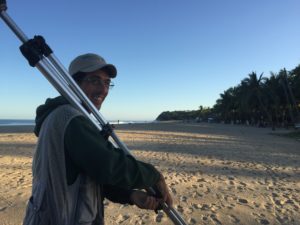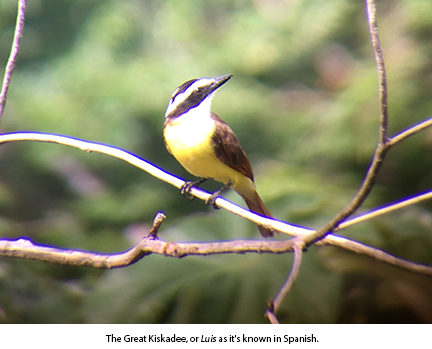Luis whips his head around so quickly that a droplet of water flies out of his nose. He’s mid-sentence, walking through the heavy sand and talking about community-based management for his town, when he stops abruptly. His eyes grow wide behind his square-ish glasses, and the skin on his thin face pushes back into an enormous smile.
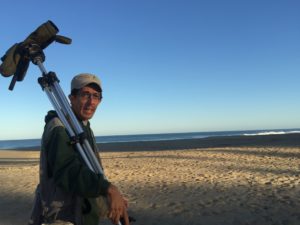
“Great Kiskadee.” This is Luis’ favorite bird. Luis loves birds so much that he can identify all the birds around us, half of which I can’t see. The Kiskadee is his favorite, he admits with charming bashfulness, because it’s called a Luis in Spanish for its song that sounds like it’s calling LuIS along the coast. This fierce-looking flycatcher — easy to identify by its size (it’s almost as big as a Robin, but far more sleek), auburn-tipped wings, a fighter-pilot-style black eyestripe, and a bright yellow belly — is one of over 300 bird species found on this mountainous coast.
At seven in the morning, I’m looking at 20 of these species in a tiny, lily-pad sprinkled bog in the sleepy seaside pueblo of San Pancho, Nayarit, Mexico. Most people come to the beach to take in the ocean, but this morning we stand with our backs to the surf. All three of us — my partner Josh, our friend Jason, and I — shiver in the icy wind that hurtles out of the mountains to escort the first rays of dawn. I can’t tell if I’m excited or hypothermic. It’s pushing 100 degrees every day around here, so I only wore a thin pair of running shorts, although based on past experience I stuffed my down coat in my bag. I’m shivering a little less than Josh and Jason, whose cotton sweatshirts are no match for the wind. I’m here at the slow crack of dawn, at the edge of land and sea, to find out from our guide, Luis Morales, what’s happening to birds as a result of climate change.
I have a confession; I’m not just interested in learning about changes in climate. I’m also here to see and hear birds. I’m a birder. I don’t keep a list, but I do have three bird guides and I spend hours at sea attempting to identify storm-petrels or (what a friend and bird guide finally told me are) phalaropes. I’ve managed to pass my enthusiasm to Josh and fellow boating friend Shannon, both of whom will now pause mid-step to turn their eyes up to wonder at a whistle or flash of feathers.
Birders are not known for their lack of fervor, and as soon as I meet Luis my inner bird geek freaks out. Luis is the real deal. He can identify birds by a song, a flight pattern, or a habit, a rare skill that requires years of dedication. Birders will pay thousands of dollars to travel the world with someone who can help them see and identify an exotic bird because there aren’t many people in the world who can do this. Luis has that birding skill; he’s tuned into birds the way a mother can hear her child’s cry, no matter how faint. In the middle of a sentence, he cocks his head and a slight smile spreads to his lips, his thin face unable to contain his childlike delight:
“West Mexican Chachalaca.”
“Blue-footed booby.”
“Yellow-winged cacique.”
Over the next few hours, Luis would take us on a spellbinding journey through 50 years of San Pancho’s history. He would show us that, while climate change may be the last feather that tips the scales of survival, it is 50 years of political agendas and subsequent land use that have created the conditions for the demise, or endurance, of migratory birds.
* * * *
Luis calls his discovery of birds his “second moment of fascination.” He grew up in Guadalajara, Mexico’s second-largest city, five hours inland from San Pancho. When he came to Puerto Vallarta’s coast and went snorkeling for the first time, he fell in love with the enchantingly colored corals on the reefs. He pursued his studies first in Ensenada, then in Oaxaca, where he received his degree in marine biology. Over time he found himself drawn more to education, hoping to preserve the fading and dwindling corals. Eventually, he moved to San Pancho, following his wife, who works on women’s issues. It was at the edge of the sea that he started to notice the brilliant birds around him.
“I suppose I went from chasing color underwater to color on land.” His eyes twinkle to match his open-mouthed, uninhibited smile. We’ve joined Luis on this unusually chilly morning for his San Pancho Bird Observatory tour.
Luis’ enthusiasm almost makes me forget about my knees, which have gone strangely numb. He opens his tripod effortlessly and through his spotting scope finds a bird, a Purple Gallinule, within seconds. The scope is a mini-telescope designed for seeing the wonders of earth’s more skittish creatures. I have spent agonizing minutes trying to find a bird in a scope, so Luis’ prowess doesn’t go unnoticed.
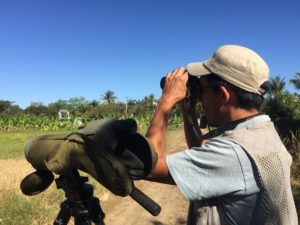
We stand on a low, crumbling concrete wall that juts into the estuary waters, and I step forward tentatively to look through the scope at the bird, which I never detected with my eyes or binoculars. A purple head pokes out of the reeds, followed by short iridescent green feathers covering a bulky, round body. The stubby red bill makes it look exactly like what Luis calls it: a mutant chicken.
When I ask Luis if he sees different birds now because of climate change, the question is so all-encompassing that it’s almost difficult for him to offer just a few examples. The question is so obtuse that he almost scoffs, but does so in a manner that says ‘this has been happening, this is just the way it is.’ So many of the birds he sees have moved since he came here just nine years ago. For people like Luis, careful observers of the natural world, the shifting of species is remarkable, distinct, and thorough.
One of the most recent examples of change is the Sinaloa Crow. The southern limit of the Sinaloa Crow, endemic to northwest Mexico, used to be San Pancho. Last year, for the first time, it moved 20 more miles south down the coast to Sayulita. This is the main way that birds are affected by climate change; the range where they can live shifts. Unlike the Sinaloa Crow, a recent Audubon study of birds in the U.S. and Canada found that the majority of birds have shrinking ranges. But the study conspicuously neglects Mexico. Why?
It all comes down to data. Mexico doesn’t have consistent bird data over time, but Mexico does have a growing group of citizen scientists. People like Luis are the observers and the recorders of this phenomenon, and what we know about birds is dependent on people like him. Luis uses a phone app called eBird, whose Spanish version is called aVerAves, or ToSeeBirds, to record each species he sees daily. He can then share the list online and with his clients. Anyone can use this app; about 100,000 people added birds last year globally to eBird, and Mexico already has over one million records since aVerAves started eight years ago. Cornell’s Lab of Ornithology and the National Audubon Society developed eBird first in 2002, and the app is a hallmark of citizen science. People can keep a record of all of their bird sightings, and all of the data about birds is made publicly available. This is a dataset that can be hugely useful to science.
Sometimes. It turns out that Mexico’s data doesn’t paint an even picture of the country, since most of the data comes from coastal communities marked by tourism. This is great for me, but mediocre for science. This inconsistent clumping means you have to aggregate the data, or essentially zoom out and get a lot less specific when trying to look at the whole country. I learned this from the lead author of the only study that attempts to understand how climate change affects birds in Mexico.
* * * *
Dr. A. Town Anderson, professor of Ecology and Evolutionary Biology at the University of Kansas, has been following birds around Mexico since his doctoral dissertation work 26 years ago. He compiles huge databases summarizing the distribution of species — figuring out what birds are where, and when. Town and two of his colleagues at the National Autonomous University of Mexico, created the ‘Atlas of Distribution of Birds of Mexico.’ In an academic community that is focused on quick answers and publishing papers, his data has led him the opposite way, asking questions that take decades to answer.
When I ask him what exactly this Atlas is, he laughs out loud. It turns out the Atlas represents 20 years of searching natural history museums throughout the world, half of which (about 85) had digitized their records when they started, and he and his colleagues had to painstakingly check the documentation. For the other 85 museums, they had to physically go in and find, record, and digitize all the specimens or records themselves.
There’s an old-school data drain that happens in biodiversity. The tropics contain the biodiversity of the world, but the museums that cataloged and house that diversity are in North America and Europe, and they don’t always want to share these reams of crusty files with researchers from the countries where the specimens were taken. So, Town and his colleagues had to go abroad to find the historical birds of Mexico.
They ended up just short of half a million records.
They did all this because there’re no long-term studies of birds in Mexico. Luis has diligently recorded birds for eight years in San Pancho, but that’s not enough time or places to detect or measure climate change on a regional or global scale. To understand the impacts of climate change, or any change over decades, requires a long-term look at the same places, at the same times, for many years. In the United States, for example, there are breeding bird surveys that have occurred every year at the same location since the 1960s.
“But Mexico is just a random collection of specimens and observational data. You can’t just go to one place or point in time and know anything [about change.]”
Town and his colleagues used the huge, imperfect datasets from their meticulously categorized Atlas along with the eBird/aVerAves data to document where the bird fauna has changed. Once they could see where bird ranges had changed, they could then ask why.
They came up with three possible drivers: precipitation, temperature, and land use. All three of these factors have changed in Mexico since 1980. Town and his colleagues expected all three would have an impact. Instead, only temperature appeared to affect birds.
These results wonderfully illustrate the effects of climate change. As the temperature heats up, which it has since 1980, almost all of the ranges of Mexico’s 115 endemic birds have shrunk. Only a few, like the Sinaloa crow in Luis’ backyard, have expanded their ranges.
But the data also says that land use change doesn’t matter — that birds don’t care if they are in a cloud forest or a cornfield. However, a mountain of research shows that this isn’t true — birds can’t breed without cover, food, and places and materials to build nests. So, if they could capture how temperature affects birds, why couldn’t they say the same for land use change?
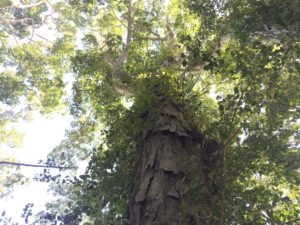
The explanation lies in the data. To use the random bird observations of their Atlas and eBird, they had to aggregate the data, or zoom way out. They used 100 square kilometer pixels, which lumps everything that happens in 100 kilometers together and calls it all the same. However, land use change, like chopping down forest for fields, usually happens over time and on the scale of acres and hectares, not 10,000 kilometers. The researchers knew that to get a more precise picture of what’s happening, they would have to take a closer look.
Town and his colleagues went back to slow science: small-scale mapping that can get at the local, Luis-level scale. They began looking at all the sites in Mexico that were well-surveyed before 1980; for example, individual campsites where a crew sat for a month in 1960, recording all the birds they saw. Now, students are resurveying those sites, point by point. Many cloud forests are now cornfields, so it won’t be a surprise that the birds once there are now gone. But, they also pick the nearest site where the forest isn’t gone and that matches all the variables from the farmed site (elevation, exposure, aspect) to see if they can start to glean a more exact picture of how climate change eats away at biodiversity.
I asked Town if he could think of one species that had suffered the most. Instead, he pointed to a region, the northern deserts. These are the flat parts of Mexico; mountains mostly line the coasts. Birds in the mountains have a relatively short distance to travel up or down the slope as conditions change. But in flat areas and desert climes, the species can’t adapt with elevation. So they slowly, or quickly, disappear.
What about the birds we see at sea, I ask? Town says the data is impossibly sparse. No one has any idea of the impact or rate of change for birds at sea and on the coasts.
Except, possibly, people like Luis.
* * * *
Standing on the concrete wall in San Pancho, Luis tells me that even small changes made in human development affect the birds he sees. It all has to do with water. When the main street in town was paved a few years ago, this changed the water runoff, which changed the drainage into the estuary and the birds he sees there. Even the wall we stand on tells a story of the struggle for habitat; it represents a protracted fight between a developer and the town. If completed, the wall will choke off water to the estuary, drying up most of the marsh and leaving 30 species of birds without shelter and food.
It’s tough to try to reflect these changes if you’re looking from the 100 square kilometer level.
But it’s not just about a few snapshots of land use change. Luis explains that the fate of the estuary has even deeper roots in the political history of Mexico. In the 1970s, Mexican President Luis Echeverría had a social and economic model to promote rural agricultural development, and San Pancho fit that bill. Tax dollars built warehouses along the estuary, and funds flooded this coastal town. But there was already a natural source for farming, the coconut palm. The palm trees in San Pancho have small coconuts, a little bigger than a walnut husk, and they are rich in oil.
“I like to call these the seeds of development.” Luis holds the brown nut in his palm. We’ve made our way from the estuary across the highway to a trail he’s painstakingly traced into the jungle. We’re still within sight of the crashing surf, but we’re ensconced in the humidity and stillness of the forest.
“People came to the coast from inland to collect these little cocos. Locals didn’t have to turn to agriculture, they could harvest the seeds. This stretch of forest was preserved while much of the jungle around us was turned to farmland. This brought people to the coast.” Luis tilts his head — “Did you hear that? Gray hawk. (Grin.) So now, we look to the forest itself to help conserve this habitat.” He goes on to talk about another tree shading our walk, the Capomo, which produces a grape-sized seed prized for its antioxidants and currently exported to the health-obsessed in Seattle by the half-ton as a coffee substitute.
Eventually, both Echeverría’s policies and the coconut oil market dried up. NAFTA opened up the agricultural base of Mexico and San Pancho to an international market in the 1990s, putting most farmers out of work as cheap food pushed into Mexico. The town languished until land speculation ran wild in the last 15 years, as homes and a golf course were built with encouragement from the government. (Even though the town has no high school, it has a golf course.) Developers eyed the forested slopes, which hold together the mountain soils that would otherwise fill the estuary, and the town, during the wet season.
That development pressure still exists, but the town has managed to find its voice. A group of local citizens, a mix of foreigners and Mexicans, has fought hard to maintain their small estuary, despite the intense pressure of developers who would like to extend the concrete wall and destroy it. It’s only 200 meters of wall, but that wall represents the end of a functioning estuary, and thus the end of the bird refuge. In other ways, too, the town is leaning toward sustaining itself. A community organization called Entre Amigos recently turned the neglected agricultural warehouses into a recycling center, and the beach and town are unusually free of plastic and trash as a result.
NAFTA opened the gate for the development glut and tore apart the agricultural-based economy of Mexico, but Luis notes that it has also opened the door for conservation partnerships. He had dreamt of partnerships between bird observatories throughout Central and North America, but he thought this was only a fantasy, a utopia. However, through the organization Partners in Flight, he founded the San Pancho Bird Observatory in 2011, and he works with conservation partners from the Klamath Bird Observatory in Oregon to find funding and birders. Throughout Latin America, tiny bird conservation organizations flock together to form “Business Conservation Plans,” meeting with each other and supporting the effort to save these patches of bird refuge, with an eye to the climate science.
“We live at the interface of sea, city, and jungle,” Luis reminds me. Every sea bird that we see from the sailboat must come to land to nest and reproduce — so everything depends on the health of the land.
Back on the trail, an orange-fronted parakeet chirps invisibly from low in the forest canopy. All species of parrots and parakeets are protected in Mexico, but they are still frequently poached as pets — they’re loud, so they’re easy to catch. We walk past a young family that waves and smiles from their dirt-floor home.
“If we don’t feed the birds for them to feed us, then people in the interface of urban and jungle will poach the parakeets or cut down the trees. This is why bird conservation needs business plans.”
As we walk the dirt road from the trail to Luis’ house, he asks me if I know the Chinese ideogram for crisis. He tells me that the same character for crisis also means something like opportunity.
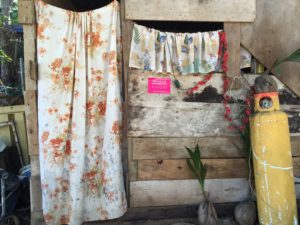
“I think every challenge brings an opportunity, of equal and opposite proportion. The Luigi Principle.” He grins. We walk into the shade of his garden, and he gasps as a male Painted Bunting lands at his birdbath. He nearly sputters as he points out this ridiculously colorful bird. From somewhere in the trees behind his house, a bird calls ‘Luiiiss, Luiiiss, Luiiiss.’
